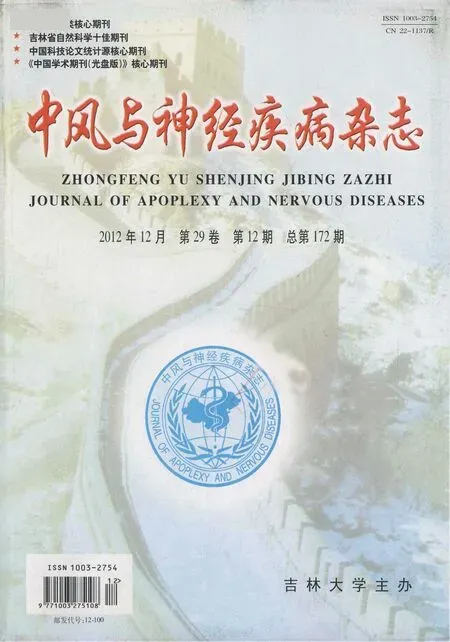Palmitoylethanolamide对脑缺血再灌注损伤作用的研究进展
2012-01-23刘雅洁综述金永华校审
刘雅洁综述, 金永华校审
脑缺血再灌注损伤(cerebral ischemia reperfusion)是指颅内动脉狭窄或闭塞,导致局部血流量降低或停止一段时间,脑血流恢复后,反而引起脑组织损伤加重的现象。十六酰胺乙醇(Palmitoylethanolamide,PEA)是酰基乙醇胺类(N-acylethanolamines,NAEs)家族的一员,因为其结构与内源性大麻素anandamide相似而引起研究者广泛的兴趣,大量研究表明PEA具有镇痛、抗炎、抗惊厥、神经保护等作用,本文拟就PEA在脑缺血再灌注过程中的作用进行综述。
1 Palmitoylethanolamide
1.1 Palmitoylethanolamide的简介 PEA是酰基乙醇胺类家族的一员,因为其结构及药理作用与内源性大麻素anandamide相似,且作用于大麻素受体,所以被称为内源性大麻素类似物。实际上,人们认识PEA的时间只有几十年,1943年,Coburn和Moore等人发现给患有风湿热的孩子吃鸡蛋黄,具有退热作用。此后的研究证明这种起作用的物质为一种脂质,存在于蛋黄[1]、花生和大豆[2]中。1957 年,Kuelu等人发现从大豆、蛋黄中分离出来的这种脂质为PEA,并证明其在几内亚猪体内有抑制炎症的作用[3]。1965年,Bachur等人发现PEA存在于哺乳动物的组织中,包括脑组织[4]。但是人们真正关注PEA是从1992年Devanen等人发现的anandamide,且这种内源性大麻素的结构与PEA相似开始的[5]。此后人们相继发现 PEA 具有抗炎[6]、镇痛[6]、抗惊厥[7]、神经保护[8]等作用,并且因为 PEA 具有抗炎作用,曾在临床上用于治疗流感引起的呼吸道症状[9]。
1.2 大麻素受体 经典的大麻素受体包括CB1受体和CB2受体,它们均属于G蛋白偶联受体。1988年,Matsuda等人发现了大麻受体亚型CBI受体,它们主要分布于中枢和外周组织中,作用于中枢的CB1受体具有降低体温、抗癫痫、改善记忆、镇静等作用,作用于周围的CB1受体具有镇痛、抑制小肠活动等作用。1993年Munro等成功克隆大麻受体亚型CB2受体,CB2受体主要分布于脾、扁桃体、淋巴结等免疫器官,激活CB2受体具有镇痛和抗炎作用[10]。此外,研究发现内源性大麻素作为配体还作用于辣椒素受体(vanilloid receptor 1 VRI)、孤单G蛋白偶联受体(The orphan grotein-coupled receptor GPR55)、过氧化物酶体增生物激活受体(peroxisome proliferator-activated receptor-alpha PPAR-α)等。
1.3 Palmitoylethanolamide作用的受体 1995年,Facci等人研究发现PEA作用于肥大细胞上的CB2受体[11],但是接下来的大量研究表明PEA在生理浓度并不作用于CB2受体。令人迷惑的是,Conti等人研究证明 CB2受体拮抗剂SR144528可以抑制PEA的大部分药理作用,包括镇痛、抗炎[12]等作用。大量研究发现PEA作为内源性配体还作用于PPARα受体和GPR55受体,研究已经证明PEA的抗炎作用是通过作用于PPARα受体实现的[13],激活GPR55受体后具有抑制炎症、减少神经性疼痛等作用[14]。
2 脑缺血再灌注损伤的简介
缺血是指颅内动脉狭窄或闭塞,导致局部血流量降低或终止,引起局部脑组织缺血或梗死,再灌注则是指被阻的血管再通或周围侧支循环开放,使缺血组织部分或全部恢复血液供应。而脑缺血再灌注损伤则是指因缺血的脑组织恢复血流供应后,反而引起该组织原有病变的加重的现象,研究表明脑缺血再灌注损伤的发生机制主要与氧自由基形成、钙超载、白细胞激活等有关。
3 Palmitoylethanolamide对脑缺血再灌注损伤的作用
大量动物实验已经证明大麻素对脑缺血再灌注具有保护作用,而PEA作为“内源性大麻素类似物”,研究发现其具有神经保护作用,且在中枢神经系统中含量很高,尤其在缺血的脑组织中含量明显增高[15],由此提示PEA在脑缺血过程中可能会起到一定作用。Philippe Le’picier等人研究发现PEA对大鼠离体的心脏在缺血再灌注损伤中具有保护作用[16],Rosanna Di Paola等人研究证实 PEA 对小肠、肾脏缺血再灌注损伤亦存在显著的保护作用[17,18]。那么PEA在脑缺血再灌注损伤中是否有保护作用呢?Markus Schomacher等人通过动物实验,用线拴法制造大脑中动脉缺血再灌注模型(middle cerebral artery occlusion,MCAO),然后实验组给予不同剂量的PEA腹腔注射,测量梗死体积及神经功能评分,结果PEA高剂量组的梗死体积比对照组减少35%[19]。2010年,Garq P等人亦进行相似的动物实验,结果PEA组显著减少梗死体积、改善神经功能缺损症状、抑制炎症、减少细胞凋亡[8]。近期Ahmad等人再次就PEA对脑缺血再灌注的保护作用进行研究,结果显示PEA组的梗死体积亦比对照组显著减少,且此研究还证实PEA在脑缺血再灌注中具有抗凋亡、抗氧化、抑制炎症、改善神经功能缺损症状、减少脑水肿、保护血管等作用[20]。由此证明PEA在脑缺血再灌注中具有保护作用。
4 Palmitoylethanolamide在缺血再灌注损伤中可能的作用机制
PEA在脑缺血再灌注损伤中作用的机制仍不十分明确,目前认为可能的机制如下:(1)大量研究表明内源性大麻素在脑缺血再灌注损伤中的保护作用主要通过作用于CB1及CB2受体实现的,尤其是CB1受体拮抗剂与CB2受体激动剂联用可起到显著的保护作用[21],但目前普遍认为PEA的生理浓度并不作用于CB1及CB2受体,近期Rosanna Di Paola对肾脏缺血再灌注的研究证实PEA在肾脏缺血再灌注损伤中的保护作用主要通过作用于PPARα受体完成[18]。目前研究已经证实PEA的抑制炎症和神经保护作用与PPARα受体明显相关,那么PEA在脑缺血再灌注损伤中的保护作用是否与PPARα受体有关呢?仍需进一步研究。(2)PEA可通过竞争性抑制anandamide的水解酶FAAH对anandamide的水解作用,增加anandamide的含量而发挥作用,这种现象被称为“随从效应”[22]。(3)PEA通过激活脑干的PPARα受体可刺激神经类固醇的分泌[23],这种神经类固醇可作用于GABA受体[23]、增加神经元的存活[24],从而起到保护作用。(4)PEA通过细胞内途径发挥神经保护作用,其在脑缺血模型中可通过减少NF-κB、iNOS的含量及控制炎症、减少神经元凋亡而具有保护作用[8]。
5 展望
缺血性脑卒中已经严重威胁人们的健康和生命,目前主要有溶栓和抗血小板治疗,但研究已经证明给予脑保护药物辅助治疗有助于缺血性脑卒中的预后,PEA的药理作用使其具有潜在的重要临床意义,但PEA在脑缺血再灌注方面的研究仍然较少,且在缺血性脑卒中的保护作用的机制仍不能明确,对PEA的研究任重而道远。
[1]Coburn AF,Graham CE,Haninger J.The effect of egg yolk in diets on anaphylactic arthritis(passive arthus phenomenon)in the guinea pig[J].Journal of Experimental Medicine,1954,100(5):425-435.
[2]Long DA,Martin AJ.Factors in arachis oil depressing sensitivity to tuberculin in BCG infected guinea pigs[J].Lancet,1956,270(6921):464-466.
[3]Kuehl FA,Jacob A,Ganley OH,et al.The identification of N-(2-hydroxyethyl)-palmitamide as a naturally occurring anti-inflammatory agent[J].Journal of the American Chemical Society,1957,79:5577-5578.
[4]Bachur NR,Masek K,Melmon KL,et al.Fatty acid amides of ethanolamine in mammalian tissues[J].Journal of Biological Chemistry,1965,240(3):1019-1024.
[5]Devane WA,Hanus L,Breuer A,et al.Isolation and structure of a brain constituent that binds to the cannabinoid receptor[J].Science,1992,18:1946-1949.
[6]Re G,Barbero R,Miolo A,Di Marzo V,et al.Palmitoylethanolamide,endocannabinoids and related cannabimimetic compounds in protection against tissue inflammation and pain:potential use in companion animals[J].Vet J,2007,173(1):2130.
[7]Lambert DM,Vandevoorde S,Diependaele G,et al.Anticonvulsant activity of N-palmitoylethanolamide,a putative endocannabinoid,in mice[J].Epilepsia,2001,42(3):321-327.
[8]Garg P,Duncan RS,Kaja S,et al.Intracellular mechanisms of N-acylethanolamine-mediated neuroprotection in a rat model of stroke[J].Neuroscience,2010,166(1):252-262.
[9]Masek K,Perlik F,Klima J,et al.Prophylactic efficacy of N2 hydroxyethyl palmitamide(Impulsin)in acute respiratory tract infections[J].Eur J Clin Pharmacol,1974,7(6):415-419.
[10]Ibrahim MM,Deng H,Zvonok A,et al.Activation of CB2 cannabinoid receptors by AM1241 inhibits experimental neuropathic pain:pain inhibition by receptors not present in the CNS[J].Proc Natl Acad Sci Proceedings of the National Academy of Sciences of the U nited States of America,2003,100(18):10529-10533.
[11]Facci L,Dal Toso R,Romanello S,et al.Mast cells express a peripheral cannabinoid receptor with differential sensitivity to anandamide and palmitoylethanolamide[J].Proc Natl Acad Sci U S AProceedings of the National Academy of Sciences of the United States of A-merica,1995,92(8):3376-3380.
[12]Conti S,Costa B,Colleoni M,et al.Antiinflammatory action of endocannabinoid palmitoylethanolamide and the synthetic cannabinoid nabilone in a model of acute inflammation in the rat[J].British Journal of Pharmacology,2002,135(1):181-187.
[13]Lo Verme J,Fu J,Astarita G,et al.The nuclear receptor peroxisome roliferator-activated receptor-alpha mediates the anti-inflammatory actions of palmitoylethanolamide[J].Molecular Pharmacology,2005,67(1):15-19.
[14]Staton PC,Hatcher JP,Walker DJ,et al.The putative cannabinoid receptor GPR55 plays a role in mechanical hyperalgesia associated with in?ammatory and neuropathic pain[J].Pain,2008,139(1):225-236.
[15]Franklin A,Parmentier-Batteur S,Walter L,et al.Palmitoylethanolamide increases after focal cerebral ischemia and potentiates microglial cell motility[J].Journal of Neuroscience,2003,23(21):7767-7775.
[16]Philippe Lepicier P,Jean-Francois Bouchard JF,Caroline Lagneux C,et al.Endocannabinoids protect the rat isolated heart against ischaemia[J].British Journal of Pharmacology,2003,139(4):805-815.
[17]Di Paola R,Impellizzeri D,Torre A,et al.Effects of palmitoylethanolamide on intestinal injury and inflammation caused by ischemiareperfusion in mice[J].J Leukoc Biol,2012,91(6):911-920.
[18]Di Paola R,Impellizzeri D,Mondello P,et al.Palmitoylethanolamide reduces early renal dysfunction and injury caused by experimental ischemia and reperfusion in mice[J].Shock,2012,38(4):356-366.
[19]Schomacher M,Muller HD,Sommer C,et al.Endocannabinoids mediate neuroprotection after transient focal cerebral ischemia[J].Brain Res,2008,1240:213-220.
[20]Ahmad A,Genovese T,Impellizzeri D,et al.Reduction of ischemic brain injury by administration of palmitoylethanolamide after transient middle cerebral artery occlusion in rats[J].Brain Res,2012,1477:45-58.
[21]Zhang M,Martin BR,Adler MW,et al.Modulation of the balance between cannabinoid CB1 and CB2 receptor activation during cerebral ischemic/reperfusion injury[J].Neuroscience,2008,152(3):753-760.
[22]Jonsson KO,Vandevoorde S,Lambert DM,et al.Effects of homologues and analogues of palmitoylethanolamide upon the inactivation of the endocannabinoid anandamide[J].Br J Pharmacol,2001,133(8):1263-1275.
[23]Sasso O,La RG,Vitiello S,et al.Palmitoylethanolamide modulates pentobarbital-evoked hypnotic effect in mice involvement of allopregnanolone biosynthesis[J].Eur Neuropsychopharmacol,2010,20(3):195-206.
[24]Charalampopoulos I,Remboutsika E,Margioris AN,et al.Neurosteroids as modulators of neurogenesis and neuronal survival[J].Trends Endocrinol Metab,2008,19(8):300-307.
